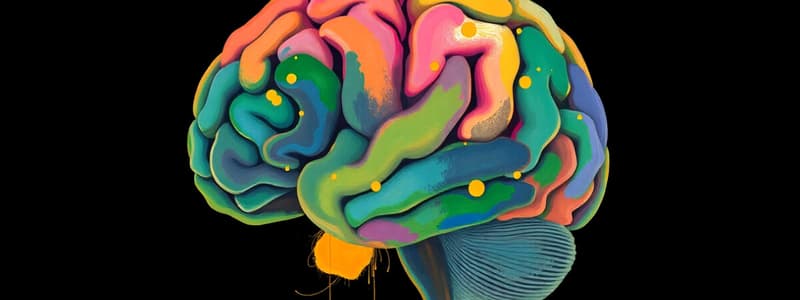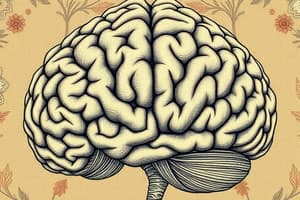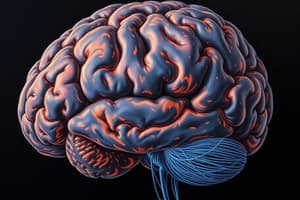Podcast
Questions and Answers
Which cerebellar lobe is primarily associated with motor learning and adapting motor programs for future accuracy?
Which cerebellar lobe is primarily associated with motor learning and adapting motor programs for future accuracy?
- Anterior Lobe
- Flocculonodular Lobe
- All lobes contribute equally to motor learning
- Posterior Lobe (correct)
What is the primary function of the cerebellar deep nuclei?
What is the primary function of the cerebellar deep nuclei?
- Coordinating eye movements and balance
- Receiving sensory input directly from the spinal cord
- Integrating motor commands from the cerebellum and relaying them to other brain regions (correct)
- Relaying motor commands from the cerebellum to the cerebral cortex
Which of the following statements accurately describes the relationship between the cerebellar vermis and the paravermis?
Which of the following statements accurately describes the relationship between the cerebellar vermis and the paravermis?
- The vermis receives input from the contralateral side of the body, while the paravermis receives ipsilateral input.
- The vermis coordinates movements of the distal limbs, while the paravermis coordinates movements of the trunk.
- The vermis coordinates movements of the trunk and axial muscles, while the paravermis coordinates movements of the distal limbs. (correct)
- The vermis primarily controls balance, while the paravermis controls voluntary movements.
Damage to the flocculonodular lobe of the cerebellum is most likely to result in which of the following symptoms?
Damage to the flocculonodular lobe of the cerebellum is most likely to result in which of the following symptoms?
Which of the cerebellar deep nuclei is most closely associated with the spinocerebellum?
Which of the cerebellar deep nuclei is most closely associated with the spinocerebellum?
Which of the following best describes the primary function of the spinocerebellum?
Which of the following best describes the primary function of the spinocerebellum?
Which of the following statements accurately describes the role of Purkinje cells in the cerebellum?
Which of the following statements accurately describes the role of Purkinje cells in the cerebellum?
Which of the following arteries supplies blood to the cerebellar hemispheres?
Which of the following arteries supplies blood to the cerebellar hemispheres?
What role does the periaqueductal gray (PAG) play in pain relief?
What role does the periaqueductal gray (PAG) play in pain relief?
What characterizes neuropathic pain?
What characterizes neuropathic pain?
Which statement best describes peripheral sensitization?
Which statement best describes peripheral sensitization?
How do the basal ganglia and cerebellum differ in their functions?
How do the basal ganglia and cerebellum differ in their functions?
What occurs during central sensitization?
What occurs during central sensitization?
What indicates an issue with the basal ganglia?
What indicates an issue with the basal ganglia?
What happens when the direct pathway of the basal ganglia is activated?
What happens when the direct pathway of the basal ganglia is activated?
Which brain structures are considered input nuclei of the basal ganglia?
Which brain structures are considered input nuclei of the basal ganglia?
What is a characteristic finding in lower motor neuron lesions?
What is a characteristic finding in lower motor neuron lesions?
Which cranial nerve provides parasympathetic innervation to the submandibular and sublingual glands?
Which cranial nerve provides parasympathetic innervation to the submandibular and sublingual glands?
What occurs if there is a lesion at the stylomastoid foramen?
What occurs if there is a lesion at the stylomastoid foramen?
Which condition results from damage to the facial nerve at the internal acoustic meatus?
Which condition results from damage to the facial nerve at the internal acoustic meatus?
Which condition is linked to the proximity of the abducens nerve and the facial nerve?
Which condition is linked to the proximity of the abducens nerve and the facial nerve?
What is the primary function of the ophthalmic division (V1) of the trigeminal nerve?
What is the primary function of the ophthalmic division (V1) of the trigeminal nerve?
Which of the following is a typical reflex finding in lower motor neuron lesions?
Which of the following is a typical reflex finding in lower motor neuron lesions?
The autonomic nervous system has which type of neuron system?
The autonomic nervous system has which type of neuron system?
What describes the primary function of aquaporins?
What describes the primary function of aquaporins?
Which statement is false regarding net diffusion?
Which statement is false regarding net diffusion?
In Fick's first law of diffusion, what does the term 'J' represent?
In Fick's first law of diffusion, what does the term 'J' represent?
How does membrane thickness affect diffusion, according to Fick’s law?
How does membrane thickness affect diffusion, according to Fick’s law?
Which type of solute requires carrier-mediated transport to cross a membrane?
Which type of solute requires carrier-mediated transport to cross a membrane?
What factor does NOT influence the rate of diffusion across a membrane?
What factor does NOT influence the rate of diffusion across a membrane?
The partition coefficient (Kp) is defined as what?
The partition coefficient (Kp) is defined as what?
Which description is accurate regarding diffusion over distances?
Which description is accurate regarding diffusion over distances?
What type of function does the mandibular branch (V3) of the trigeminal nerve serve?
What type of function does the mandibular branch (V3) of the trigeminal nerve serve?
Which foramen does the maxillary branch (V2) of the trigeminal nerve pass through?
Which foramen does the maxillary branch (V2) of the trigeminal nerve pass through?
Where are the ganglia associated with the trigeminal nerve located?
Where are the ganglia associated with the trigeminal nerve located?
Which statement about the cell membrane's selective permeability is true?
Which statement about the cell membrane's selective permeability is true?
Which ion has a higher concentration inside the cell compared to outside?
Which ion has a higher concentration inside the cell compared to outside?
Which of the following statements about osmolarity is correct?
Which of the following statements about osmolarity is correct?
What is the typical pH of extracellular fluid (ECF)?
What is the typical pH of extracellular fluid (ECF)?
What role does cholesterol play in cell membranes?
What role does cholesterol play in cell membranes?
What process allows fat-soluble substances to cross the membrane?
What process allows fat-soluble substances to cross the membrane?
Which statement correctly describes the nature of diffusion?
Which statement correctly describes the nature of diffusion?
What is the role of the Na+/K+ pump in cells?
What is the role of the Na+/K+ pump in cells?
What does osmotic pressure signify in a solution?
What does osmotic pressure signify in a solution?
How does osmolarity differ from tonicity?
How does osmolarity differ from tonicity?
Which of the following accurately describes the relationship between osmosis and diffusion?
Which of the following accurately describes the relationship between osmosis and diffusion?
What characterizes the reflection coefficient of a semipermeable membrane?
What characterizes the reflection coefficient of a semipermeable membrane?
How can the Van't Hoff equation be used regarding osmotic pressure?
How can the Van't Hoff equation be used regarding osmotic pressure?
Flashcards
Periaqueductal Gray (PAG)
Periaqueductal Gray (PAG)
A group of brain structures that act as a gatekeeper for pain signals, receiving input from higher brain centers and influencing whether pain signals reach the conscious brain.
Rostroventromedial Medulla (RVM)
Rostroventromedial Medulla (RVM)
A brain region that plays a crucial role in modulating pain signals, acting as a final relay station for descending pain control pathways.
Neuropathic Pain
Neuropathic Pain
Pain arising from damage or disease affecting the nervous system, often characterized by burning, shooting, or tingling sensations.
Peripheral Sensitization
Peripheral Sensitization
Signup and view all the flashcards
Central Sensitization
Central Sensitization
Signup and view all the flashcards
Basal Ganglia
Basal Ganglia
Signup and view all the flashcards
Cerebellum
Cerebellum
Signup and view all the flashcards
Tremor at Rest
Tremor at Rest
Signup and view all the flashcards
What role does the cerebellum play in motor control?
What role does the cerebellum play in motor control?
Signup and view all the flashcards
What is ataxia?
What is ataxia?
Signup and view all the flashcards
How many lobes does the cerebellum have?
How many lobes does the cerebellum have?
Signup and view all the flashcards
From where does the cerebellum receive input?
From where does the cerebellum receive input?
Signup and view all the flashcards
What is the function of the spinocerebellum?
What is the function of the spinocerebellum?
Signup and view all the flashcards
What is the function of the vestibulocerebellum?
What is the function of the vestibulocerebellum?
Signup and view all the flashcards
What is the function of the cerebrocerebellum?
What is the function of the cerebrocerebellum?
Signup and view all the flashcards
Where does the cerebellum project its output?
Where does the cerebellum project its output?
Signup and view all the flashcards
Lower Motor Neuron Lesion
Lower Motor Neuron Lesion
Signup and view all the flashcards
Facial Nerve (CN VII) Parasympathetic Innervation
Facial Nerve (CN VII) Parasympathetic Innervation
Signup and view all the flashcards
Facial Nerve (CN VII) Pathway
Facial Nerve (CN VII) Pathway
Signup and view all the flashcards
Facial Nerve (CN VII) Lesions
Facial Nerve (CN VII) Lesions
Signup and view all the flashcards
Facial Nerve (CN VII) and Vestibulocochlear Nerve (CN VIII)
Facial Nerve (CN VII) and Vestibulocochlear Nerve (CN VIII)
Signup and view all the flashcards
Pons Lesions
Pons Lesions
Signup and view all the flashcards
Trigeminal Nerve (CN V) Divisions
Trigeminal Nerve (CN V) Divisions
Signup and view all the flashcards
Trigeminal Nerve (CN V) Motor and Sensory Function
Trigeminal Nerve (CN V) Motor and Sensory Function
Signup and view all the flashcards
Cell Membrane Selectivity
Cell Membrane Selectivity
Signup and view all the flashcards
Cell Membrane Regulation
Cell Membrane Regulation
Signup and view all the flashcards
Hydrophobic Solute Diffusion
Hydrophobic Solute Diffusion
Signup and view all the flashcards
Hydrophilic Solute Diffusion
Hydrophilic Solute Diffusion
Signup and view all the flashcards
Fluid Mosaic Model
Fluid Mosaic Model
Signup and view all the flashcards
Plasma Membrane Thickness
Plasma Membrane Thickness
Signup and view all the flashcards
Potassium Concentration Difference
Potassium Concentration Difference
Signup and view all the flashcards
Sodium, Calcium, and Chloride Concentration Difference
Sodium, Calcium, and Chloride Concentration Difference
Signup and view all the flashcards
Diffusion
Diffusion
Signup and view all the flashcards
Osmosis
Osmosis
Signup and view all the flashcards
Osmotic Pressure
Osmotic Pressure
Signup and view all the flashcards
Osmolarity
Osmolarity
Signup and view all the flashcards
Tonicity
Tonicity
Signup and view all the flashcards
Aquaporin
Aquaporin
Signup and view all the flashcards
Glucose Transporter
Glucose Transporter
Signup and view all the flashcards
Sodium-Potassium Pump (Na+/K+ Pump)
Sodium-Potassium Pump (Na+/K+ Pump)
Signup and view all the flashcards
What is a phospholipid?
What is a phospholipid?
Signup and view all the flashcards
What are channels in cell membranes?
What are channels in cell membranes?
Signup and view all the flashcards
What are pores in cell membranes?
What are pores in cell membranes?
Signup and view all the flashcards
What is diffusion?
What is diffusion?
Signup and view all the flashcards
What factors influence diffusion rate?
What factors influence diffusion rate?
Signup and view all the flashcards
What are non-electrolytes?
What are non-electrolytes?
Signup and view all the flashcards
What is Fick's Law of Diffusion?
What is Fick's Law of Diffusion?
Signup and view all the flashcards
How do hydrophobic molecules cross cell membranes?
How do hydrophobic molecules cross cell membranes?
Signup and view all the flashcards
Study Notes
Week 1 Nervous System and Pain
- The nervous system is composed of the central nervous system (CNS) and peripheral nervous system (PNS).
- The nervous system requires high energy, glucose, and blood flow. Disruption of nutrients and oxygen can lead to neuronal death.
- Ascending pathways carry sensory information from the periphery to the CNS.
- Descending pathways carry information from the CNS to the periphery.
- The brainstem includes the midbrain, pons, and medulla.
- The cerebellum coordinates movement.
- The basal ganglia regulates movement.
- The thalamus relays sensory information.
- The hippocampus is involved in memory.
- The amygdala is involved in emotions.
- Neurons are the basic units of the nervous system.
- Calcium is necessary for synaptic transmission.
- Glial cells support neurons, including oligodendrocytes, astrocytes, and microglia.
- Astrocytes form the blood-brain barrier and synthesize neurotransmitters.
- Oligodendrocytes synthesize myelin in the CNS.
- Schwann cells synthesize myelin in the PNS.
- Spinal reflexes have different neural circuits like feedforward excitation, feedforward inhibition, and convergence.
- Microglial cells remove debris after neuronal injury.
Week 2 Sensory Transduction and Somatosensation
- Sensory transduction couples stimulus detection to ion channel opening/closing.
- Sensory neurons generate membrane potentials that can trigger action potentials.
- Somatosensation provides information about internal and external body states.
- Somatosensation includes touch, position, temperature, and pain pathways.
Additional Information
- Mechanoreceptors detect light touch, pressure, and vibration.
- Types of mechanoreceptors include Meissner corpuscles, Pacinian corpuscles, Merkel cell neurite complexes, and Ruffini corpuscles.
- Sensory receptors detect stimulus intensity, duration, location, and modality.
- Receptive field size varies depending on receptor density.
- Different terms for sensations include paresthesia (tingling/numbness), anesthesia (loss of sensation), and hypoesthesia (reduced sensation.)
Studying That Suits You
Use AI to generate personalized quizzes and flashcards to suit your learning preferences.




